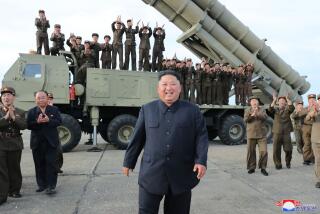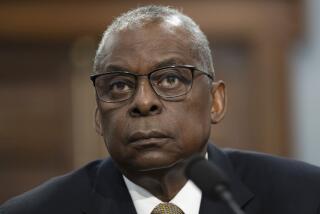North Korea and friction in the South China Sea complicate Obama’s ‘rebalance’ toward Asia
Late in his first term, President Obama announced a new emphasis on Asia and the Pacific Rim, a way of pivoting from the morass in the Middle East and focusing on a peaceful, booming region that the first Pacific-born president saw as the future.
He has visited Asia regularly since then — and will return at least twice this year for economic and security summits.
But with notable exceptions, much of the administration’s self-proclaimed “rebalance” has been dominated by emergency security matters, including North Korea’s defiant nuclear tests, friction with China in the South China Sea, and the growing threat of cyber-espionage and digital theft.
On Thursday, with about 50 world leaders in Washington for the Nuclear Security Summit, only the leaders of China, Japan and South Korea received full, formal meetings with Obama, a clear sign of his priorities.
(The White House belatedly added a shorter session with French President Francois Hollande, a crucial ally in the war against Islamic State.)
“Trilateral security cooperation is essential to maintain peace and stability in Northeast Asia,” Obama told reporters as he met with South Korean President Park Geun-hye and Japanese Prime Minister Shinzo Abe.
Later, in a separate meeting with Chinese President Xi Jinping, Obama emphasized their commitment to “denuclearization of the Korean peninsula” and praised China’s new Nuclear Security Center of Excellence, which seeks to prevent smuggling of nuclear material.
“As the two biggest economies, China and the U.S. have a responsibility to work together,” Xi said.
The favored treatment for the three Asian powers underscores the importance the White House attaches to boosting trade and security in Asia as well as the urgency of dealing with North Korea’s nuclear saber rattling and other potential conflicts.
“The rebalance [toward Asia] … the reshuffling of U.S. priorities … is one of the most significant strategic initiatives of Obama’s tenure,” said Elizabeth Economy, director of Asia studies at the nonpartisan Council on Foreign Relations.
The meetings came against the backdrop of a tumultuous U.S. presidential campaign that potentially could upend half a century of U.S. policy in northeast Asia.
The Republican front-runner, Donald Trump, has said repeatedly in recent days that South Korea and Japan may need to develop their own nuclear weapons to confront regional threats, rather than rely on the U.S. nuclear umbrella that has shielded them for decades.
“You have so many countries right now that have them,” he said Tuesday in a CNN town hall. “Wouldn’t you rather ... have Japan have nuclear weapons when North Korea has nuclear weapons?”
Whether a whim or a serious notion by Trump, the issue came up in multiple news briefings before the nuclear security summit, the fourth in a series launched by Obama in 2009 as part of his stated goal of seeing a world without nuclear weapons.
Ben Rhodes, the White House deputy national security advisor, said a pillar of U.S. foreign policy has been to prevent the spread of nuclear weapons, not to encourage it, as Trump suggests.
“That’s been the position of bipartisan administrations, everybody who’s occupied the Oval Office,” Rhodes said. “Frankly, it would be catastrophic were the United States to shift its position.”
White House aides say Obama’s carefully nurtured relationship with Xi — their meeting Thursday was their eighth face-to-face session — was crucial in getting Chinese support at the United Nations Security Council meeting on March 2 to impose stiff sanctions on North Korea, Beijing’s ally, in response to its latest nuclear test.
“It is only because the United States and China have been able to effectively work together that the United Nations imposed the toughest sanctions that have been imposed on North Korea,” White House Press Secretary Josh Earnest said. “That will pressure the North Korean regime and isolate the North Korean regime over their nuclear weapons program in a way that has positive benefits for our allies, South Korea and Japan.”
North Koreans face a “steadily growing drumbeat” for war as Pyongyang prepares for its first Workers’ Party Congress in 36 years, scheduled for May, said Victor Cha, a Korea expert at the Center for Strategic and International Studies, a nonpartisan think tank in Washington. Annual U.S.-South Korean military exercises last month have helped fuel the tension.
China has expressed its own frustration with North Korean leader Kim Jong Un.
Beijing was caught off guard by Pyongyang’s most recent underground nuclear test, on Jan. 6, a few weeks before Chinese New Year. Beijing had specifically told Kim’s government not to conduct the test, its first since 2013.
Tension with China also has been growing in the resource-rich and bitterly contested South China Sea.
In the last two years, China has used dredgers to build up remote reefs and rocky outcrops into small islands in the Spratly and Paracel chains. It has constructed airstrips and other potential military installations in areas also claimed by the Philippines, Vietnam and other nations.
The Obama administration, which says it is determined to maintain freedom of the seas on a vital waterway, has responded by dispatching warships and surveillance aircraft into areas now claimed by China.
In September, during his last visit to the White House, Xi said China did not intend to “pursue militarization” of the islands. But many U.S. officials believe he has gone back on that word.
“China is rising, which is fine, but behaving aggressively, which is not,” Defense Secretary Ashton Carter said last week at the U.S. Military Academy at West Point.
That tension has not stopped cooperation on other goals, including efforts to tackle climate change.
The White House announced Thursday that Washington and Beijing on April 22 will sign the so-called Paris Agreement, which contains pledges to reduce environment-damaging emissions. The U.S. and China are the world’s biggest carbon emitters.
Trade may be a sideline issue — especially as Asian leaders look beyond Obama and to the next U.S. president.
Trump and the Democratic front-runner, Hillary Clinton, have announced opposition to the proposed Trans-Pacific Partnership, a 12-nation free trade agreement that Obama supports. It’s unclear whether Congress will vote on the accord before he leaves office.
Times staff writer W.J. Hennigan contributed to this report.
ALSO
Elon Musk unveils Tesla Model 3 to huge fanfare
Longtime marijuana use might make you a loser
These women in Turkey saw the need for a different kind of news, despite the danger
More to Read
Sign up for Essential California
The most important California stories and recommendations in your inbox every morning.
You may occasionally receive promotional content from the Los Angeles Times.












